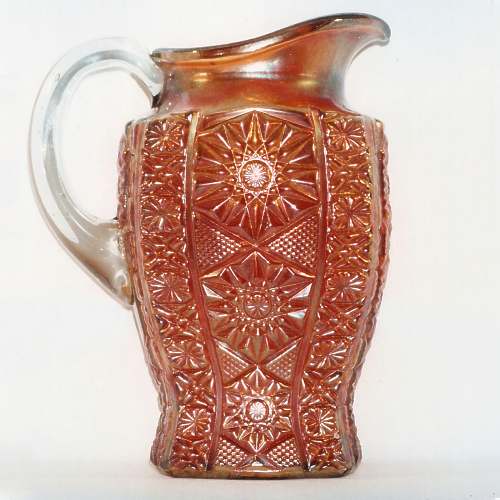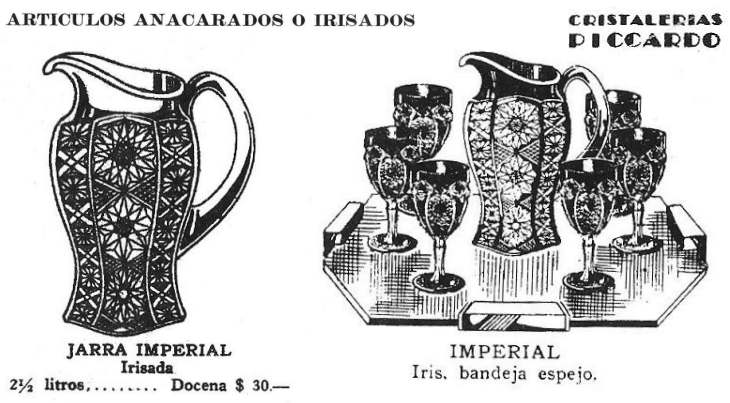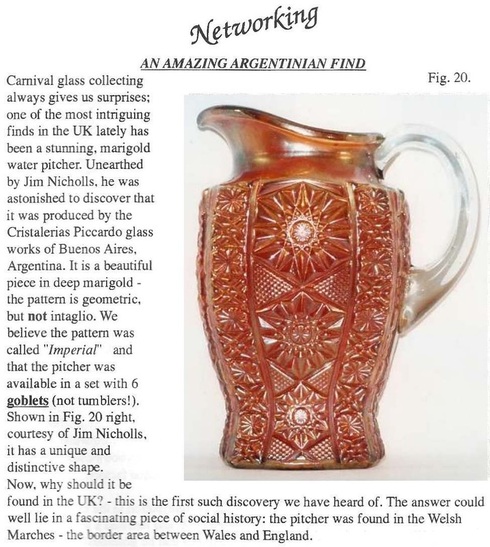Imperial by Cristalerias Piccardo
The first published account of Carnival Glass from Argentina was in the Carnival Glass Society (UK) Journal in 1986 - almost thirty years ago!
The researcher who made the discovery was the late Raymond Notley, and he presented the Carnival world with original catalogue images showing pressed, iridised glass made by Cristalerias Piccardo of Buenos Aires.
The patterns shown were Imperial, Rosas, Princess and Yvonne - in a variety of different iridised shapes.
Later, in our journal, NetworK #12, 1996, we published information about the intriguingly named Piccardo pattern called Imperial.
The researcher who made the discovery was the late Raymond Notley, and he presented the Carnival world with original catalogue images showing pressed, iridised glass made by Cristalerias Piccardo of Buenos Aires.
The patterns shown were Imperial, Rosas, Princess and Yvonne - in a variety of different iridised shapes.
Later, in our journal, NetworK #12, 1996, we published information about the intriguingly named Piccardo pattern called Imperial.
|
The Welsh Connection In NetworK #12 we asked the question why a pitcher made in Argentina might turn up in the Welsh Marches. We also found the answer! During the late 1800s, many Welsh people emigrated to South America - and particularly to Patagonia. Councillor Gordon Dennis of Loughor, South Wales, has researched this topic on a personal level as his paternal great aunt and her six sons left Wales for South America in the 1860s. The reasons for the large scale emigration were two fold: firstly there was the promise of jobs in a "land of milk and honey" and secondly, the Catholics in Wales were persecuted, thus causing them to seek a country with similar religious beliefs. The journey to South America was dreadful. Councillor Dennis' family travelled on a small sailing ship and slept on planks. They believed they were going to a tropical climate, but they arrived in winter and it was dreadful. When they got there, there was no accommodation and shacks had to be built. They became pioneers, establishing communities that they gave Welsh names to, such as Cwm Hyfryd (which means "beautiful valley"). Five out of the six sons helped on the land, but one was a bad lot and took up with criminals. Being chased by the police, he escaped by swimming a river and legend has it that he took up with the Sundance Kid! Out of all the members of Councillor Dennis' family who emigrated, only one returned to Wales, suggesting that generally, most of the emigrants stayed in their new land. Their first language is now Spanish, but we understand that Welsh is beginning to be taught ... as a foreign language! Note: Welsh settlement in Argentina began in 1865 and occurred mainly along the coast of Chubut Province in the far southern region of Patagonia. To read more on Wikipedia: en.wikipedia.org/wiki/Y_Wladfa |


